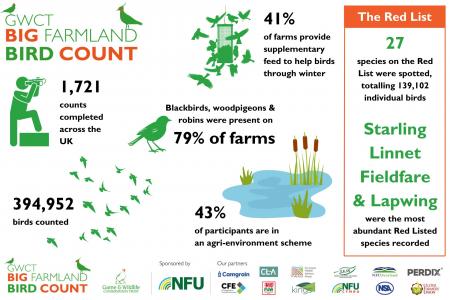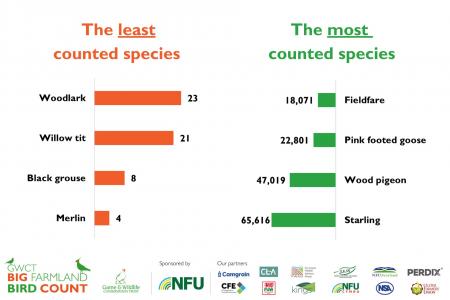19th February 2025
Two-week ‘Big Farmland Bird Count’ nears end
THIS month’s ‘Big Farmland Bird Count’ (BFBC), the annual national census of farmland birds run by the Game & Wildlife Conservation Trust (GWCT), comes to a close at the end of the weekend – but there is still time to take part.
Farmland birds have been in decline for the past 50 years and there are many ways in which the public can help them during the winter months when food is scarce and temperatures drop.
The annual census has been providing data for the past decade, highlighting which species are in the most serious trouble and how these can be helped.
As well as providing a snapshot of the bird population on UK farms, the count raises awareness of the role that farmers and other land managers play in the conservation of farmland birds.
TV presenter and farmer Adam Henson highlighted the importance of the count on BBC One’s Countryfile programme.
He said: “This year we would love to see more of our younger generation taking part, so if you are a farmer, ranger, game or forest keeper already monitoring your birds, or want to start doing so, why not see if you can get some help from your children, grandchildren or younger friends and family?
“To help younger bird spotters get interested and involved we have updated our website with some additional new and exciting easy-to-use guides and count sheets.”
Farmland birds have declined by 63 per cent since 1970 and the key to reversing that trend, and increasing biodiversity, is held by the people who are responsible for the 72 per cent of the UK’s land which is used for agriculture.
Said Henson: “The UK has lost more than 70 million wild birds over the past 50 years, with more than 60 per cent of farmland birds affected. Farmers have the opportunity to be at the forefront of any efforts to restore those populations.
“Nature-friendly farming is the way forward, and to make sure we’re getting it right, providing the best habitats and support for our farmland birds, it is important to keep records.”

In last year’s count, nearly 395,000 birds were spotted during 1,721 surveys. The most common species were starling, woodpigeon and fieldfare.
A total of 140 different species were recorded and of those, 27 were red-listed, totalling nearly 140,000 individuals.
The most abundant red list species were starling, linnet, fieldfare and lapwing, while the rarest sightings were of snow bunting, rock pipit, merlin, greenshank, golden eagle and Bittern.
Nearly 80 per cent of farms recorded blackbirds, robins and woodpigeons.
Norfolk topped the list of recording the largest number of counts, followed by Suffolk and Wiltshire.

Said the GWCT’s Dr Roger Draycott: “The count is the first and only UK-wide citizen science project to involve land managers in monitoring the state of farmland birds.
“Since the count started in 2014, it has helped us understand how wildlife is doing on our land, and it gives us a national snapshot of the state of nation when it comes to our farmland birds.
“People can really make a difference by taking part. By spending just half an hour in one spot on your farm or shoot, counting the birds you see and submitting your results to the GWCT, the results help us build a national picture of which species are benefiting from conservation efforts, and which are most in need of help.”
Signing up for the Big Farmland Bird Count is free and no specialist knowledge or equipment is required.
Find out how to take part by visiting: https://www.bfbc.org.uk/take-part/how-to-take-part/